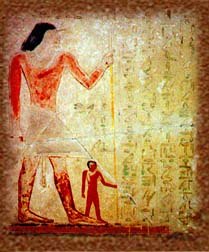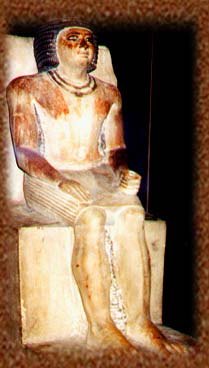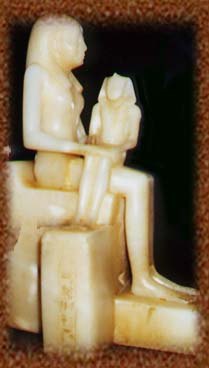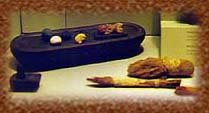| Development
of Ancient Egyptian Art |
Artistic
Conventions, Canon of Human Proportions and Colours
Rigorous
application of artistic conventions have helped create "typical"
Egyptian art that remained virtually unchanged for over three
millennia. Naturally, the sculptor (the 'one who causes life')
and the draftsman (the 'scribe of forms') followed different
sets of artistic conventions with regards to their art.
Artistic
Conventions
Paintings,
sculptured reliefs, engravings, and drawings - referred to
as two dimensional art since they are produced on flat surfaces,
whether papyrus, plastered walls, flat rock outcrops, or nicely
cut stone walls - followed specific rules dictating how to
draw the human body. Egyptians did not depict the body as
they saw it with their naked eyes, but the way they thought
corresponded to the truth, the way each body part was clearly
identifiable. Such rendition of the human figure may appear
extremely strange to us, yet, to the ancient Egyptians, these
were very logical conventions: the head was drawn in profile,
but the eye and the eyebrow were depicted in full view. Men's
shoulders and upper torso were also depicted frontally so
that the arms, hands, and fingers were visible as well. The
belly and the waist were shown in three-quarters putting the
belly button not in the middle of the stomach but more to
the side of the figure. The posterior, legs, and feet were
shown in profile thus balancing the head. The feet were always
depicted from the inside, thus showing the arch of the foot,
but from the mid-Eighteenth Dynasty onwards, the Egyptians
preferred showing the outside of the foot. Needless to say,
such contortions are absolutely impossible! Women's anatomical
perspective differed slightly since the artists had to show
the body from the under the arms all the way down to the feet
in profile in order to make apparent the breasts. Exceptions
were rare but nevertheless occurred sometimes to facilitate
a certain movement of the arms. An interesting exception was
the dwarf god Bes, who was depicted in two-dimensional art
with his face seen from the front, just like in sculpture.
|
Metchetchi and his youngest son from the 5th Dynasty
found at the Royal Ontario Museum
|

Credits: Caroline Rocheleau |
Egyptian
sculpture (three-dimensional art) has often been described
as static, very cubic, and constrained. Ancient Egyptian statuary,
unlike ancient Greek statues, had limited numbers of position
in which people could stand, sit, or kneel because artists
did not free the sculpted form from the block of stone. They
rarely created voids and spaces that would create a lighter
and more expressive sculpture. Whether this was typical Egyptian
artistic expression or, as a famous Egyptologist recently
said, the effort of an elite to define and sustain an ideology,
scholars have no explanation. However, it must be said that
wooden sculptures made of composite pieces (body parts that
could be attached to the torso like a big 3D puzzle) allowed
more possibilities of positions. Possible reasons for these
more lively sculptures may reside in the fact that any damaged
parts (during the carving or later) could easily be replaced
unlike stone sculptures, which had to be entirely re-carved
should any accident occur in the workshop. By creating a more
cubic sculpture, the Egyptian sculptors certainly avoided
the breaking small thin sections and parts easily. Statues
are primarily to be viewed from the front, although there
are a few exceptions notably the statue of King Pepy the Second
and his mother. There were fewer conventions regarding the
actual representation of the human body in three dimensions.
Sculptors depicted the body the way it really was, without
contortions.
Statue of Vizier Kai from the 5th Dynasty found in
the Musée du Louvre
|

Credits: Caroline Rocheleau |
Except
for a few cases, ancient Egyptians were depicted in a more
or less idealised manner, the way they would have wanted to
be for the rest of their eternal lives. The majority of the
time they are beautiful, young and slim, however there were
many occasions where a person was depicted both as a young
adult and as a mature person in their tombs. Signs of maturity
were a more plump stature, a longer kilt, and the person wore
no wig. People were, in some instances, depicted as being
corpulent - whether as true to nature or as a sign of prosperity.
The most impressive sculpture of corpulent man must be the
statue of Hemiunu, a royal architect, vizier, priest, scribe
(among his many titles) who worked under King Khufu's (Fourth
Dynasty). The statue (Hildesheim, Germany) must absolutely
be seen, since it is exceptional in its physical rendering
of the man, its skilled execution, and its incredible size
(it weighs around 2 tons, if I am not mistaken).
King
Akhenaton's figure also is another exception to these artistic
rules. His elongated cranium, drooping features, long neck,
pot belly, large hips and thighs, spindly arms, and short
legs are so surprising that Egyptologists have been debating
for years (and many more to come) as to the exact reason for
this caricature and strange portraiture. It must be said though,
that, in spite of the unexpected figure, Amarna art generally
conforms to regular artistic and colour conventions.
Kings
were clearly identifiable in art, as they stood much taller
than the rest of the humans, and approximately the same size
as the gods depicted in the same scene. Evidently size served
to emphasise the divine office, the social status and power
of the king. Occasionally, queens were represented as tall
as their husbands, suggesting their own importance. More often
than not, though, women - all women, queens included - were
depicted rather small, barely taller than children.
|

|
Yet,
females in ancient Egypt seem to have enjoyed much more power
than their likes in Greece or Rome. Furthermore, kings sported
royal garments and accessories, such as a variety of crowns
with a cobra (uraeus) on the brow, special kilts, a false
beard (held to the chin with a string), and crooks, flails,
and other sceptres.
Famous
Queen Hatschepsut of the Eighteenth Dynasty, even though a
woman, was depicted wearing the same accoutrement since she
was the actual ruler. Queens' regalia were much simpler, although
their regal appearance is obvious. The most famous headdress
worn by royal women is undoubtedly the vulture headdress with
the vulture's head on the brow and the wings on either side
of the ears. Queen Nefertiti (Akhenaten's wife) also wore
a unique tall blue coiffe.
Depictions
of children, royal or not, in Egyptian art also followed specific
rules. Children are easily recognisable by the simple fact
that they were depicted naked. Needless to say, Egyptian children
did wear clothes, as proven by very small garments found in
archaeological excavations. Nudity, in this particular case,
indicated the young age of the child. However, adults were
sometimes depicted naked, as a symbol of rebirth in the Afterlife
(in the case of a funerary statue) or simply because certain
tasks were better performed without clothing impeding movements.
Small children, in addition to being naked, were shown with
their index finger on their lower lip, not unlike our own
children sucking their thumbs, as well as sporting the 'side
lock of youth,' a braid of hair worn usually at one side of
the head. Adolescents, on the other hand, were represented
wearing full clothing and adult hairstyle or wigs. Yet, just
like small children, they were depicted much smaller than
their parents were, sometimes barely keen-high, no matter
how tall they really were.
|
Pepi the Second and his mother from the 6th Dynasty
found at the Brooklyn Museum
|

Credits: Caroline Rocheleau |
Interestingly,
these conventions did not apply to Pepi the Second, a six-year
old who became the fifth king of the Sixth Dynasty. Unlike
boys of his age, little King Pepi was not represented naked,
he did not sport the side-lock of youth, nor did he have his
index finger on his lower lip. The magnificent alabaster statuette
from the Brooklyn Museum shows Pepi sitting on his mother's
lap wearing his royal regalia. Decorum would not allow that
King Pepi, even though a young child, to be depicted like
other boys his age. Nonetheless, he is represented as small
as other children would be, with his mother holding him protectively.
Children
and adolescents either stood or sat quietly at their parents'
feet or accompanied them in various family activities. The
former docile behaviour was typically rendered in statuary
since artists had much less choice in their composition than
in paintings or reliefs, were they actively participate in
the action of the scene.
Canon
of Human Proportions
The
Canon of Human proportions was a square-grid of 18 units applied
to a drawn human figure (standing) allowing its reproduction
in various sizes, but always anatomically proportionate. There
were 2 squares allowed for the face (from the hairline to
the base of the neck), 10 squares from the neck to the knees,
and 6 squares from the knees to the sole of the feet. There
was a nineteenth square used for the hair, but it was not
counted with the rest of the body. A sitting figure was divided
into a 14 square-grid (15 including the hair). Not surprisingly,
the Amarna artists (Eighteenth Dynasty) had to used a different
square-grid of twenty units. The usual 6 units were kept between
the sole of the feet and the knees, but two extra squares
were added to the between the knee and the neck, creating
shorter lower legs and a longer neck if one of the squares
had been added to the neck rather than the torso.
These
square-grid divisions corresponded to general human proportions,
although Akhenaton's physical appearance is still the subject
of hot debates among Egyptologists. Nevertheless, the 18 unit
square grid remained in use until the Late Period, when the
Twenty-Sixth Dynasty adopted a square-grid of 21 and a quarter
units that was in used until the end of Pharaonic civilisation.
The same square-grid was also used in statuary and pale red
lines can still be seen on some unfinished reliefs, painting
and sculptures. The concept of the square-grid is still used
by architects, draftsmen, designers, and artists nowadays.
Colours
Ancient
Egyptian artists had a very limited palette of colours: red,
blue, yellow, green, white, and black. The symbolism of each
colour is best left unexplained at this moment as some colours
are interchangeable and colour conventions are not yet fully
understood. Although the Egyptians favoured strong, pure colours,
skilled artists sometimes worked with mixed colours such as
grey, pink, brown, or orange. Imagining all sculptures and
reliefs painted with bright, vivid colours is quite a task
for the imagination, especially since few fully painted monuments
have been uncovered by archaeologists. Yet, all the statues
and sculptured reliefs were entirely covered with thick, rich
colours, despite the inherent beauty of the stone from which
it was carved.
Paintbrushes, Pigments and Palette found at the Royal
Ontario Museum
|

Credits: Caroline Rocheleau |
Along
with the artistic conventions and canons of proportions, there
were colour conventions for artists to observe. The most interesting
colour convention was based on gender distinction. Ancient
Egyptian males were always painted in reddish-brown tones
while females had a pale yellow (sometimes pink) coloured
skin. Such colour distinction was partly symbolic of men and
women's lifestyles. Men led a more active, outdoor life as
opposed to the indoors life of women. Old men, and this is
noteworthy, were often also depicted pale skinned, symbolising
old age and a more sedentary lifestyle.
(Caroline
Rocheleau)
|
|